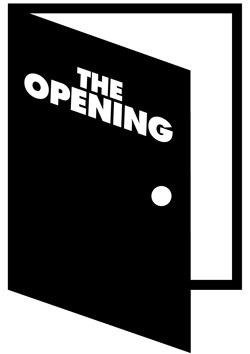
|
THE OPENING is all about introducing the fascinating, quirky and wonderful people working in and around the visual arts in Vancouver. Each week, we'll feature an artist, collective, curator or administrator to delve deep into who and what makes art happen! |
Artist and writer Kathleen Ritter is the Associate Curator at the Vancouver Art Gallery where she has worked since her return to Vancouver several years ago. She obtained a BFA from Emily Carr Institute in 1998 and an MFA from The University of Western Ontario in 2005, in-between that time working at Artspeak as Program Coordinator. A lovely and generous person, Ritter and I met on a very busy Tuesday evening in the VAG cafe for coffee.
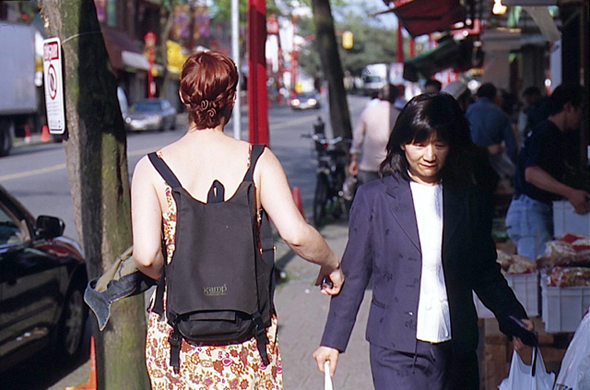
EXPECT DELAYS – Daine Borsato, “Touching 1000 People,” 2003, public intervention (Photo: Recorder)
How did you become an Associate Curator at the VAG?
Quite simply I applied for the job and I was hired. The more complicated answer is that I became interested in curating out of my own practice as an artist and a writer. When I worked at Artspeak I curated a series called ‘Expect Delays’, which came out of performances and street interventions I was doing as a part of a collective called the Ladies’ Afternoon Art Society. I was interested in how the kind of interventions that artists did in the street really differed from performance art, but also from traditional exhibition practices. This kind of performance work was not well recognized at the time, so I decided to put together a series of artists from across Canada that made us look at the street in a different way and that somehow changed our relationship to urban space. The series took place over two months in 2003 with eight artists – two from Toronto, two from Montreal and four from Vancouver. From that I experience I saw curating as a way of learning an artist’s work closely, an opportunity to redefine our understanding about a place, a practice or a set of ideas.
Is that why you went on to do a Masters at Western?
My Masters was in studio. In fact, all of my education has been in studio. When I left Emily Carr, I was making conceptual artworks while I was reading theory and doing a lot of critical writing. I was interested in different approaches to art as an artist, but also through language and through writing. I think it was this combination of things that brought me to curating.
Do you feel that it changes the way you curate having a studio education and not having a museum studies education, for instance?
I suspect it does, but it’s hard to say because I don’t know what the difference would be! I approach curating from a fairly collaborative basis. I prefer working with living artists for example, and the projects that I’m most excited about are the ones that are being made at the very moment. New or commissioned artworks for exhibitions are part of an exciting process – to actually work alongside an artist to realize something. My favourite exhibitions are the ones where I have no idea what they’re really going to look like until about a week before they open. That excitement about new work comes out of my experience as an artist, but also from working at an artist run centre, where you work in a way that’s very experimental, and very improvisational. That’s where the energy is.where the energy is.
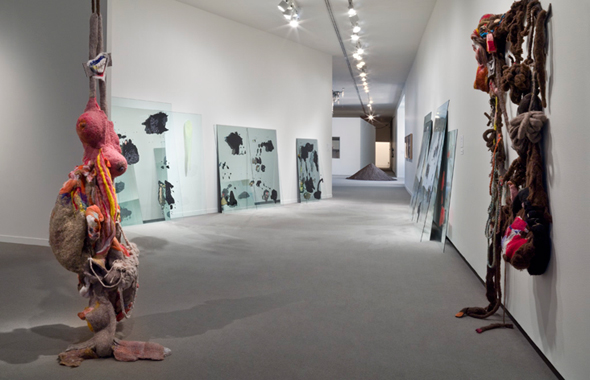
HOW SOON IS NOW - Luanne Martineau, Marina Roy, Samuel Roy-Bois, Holly Ward, Allison Hrabluik and Germaine Koh (Photo: Rachel Topham, VAG)
Do you feel it’s important as a curator to be friends with a lot of artists? Do you feel that helps in deciding who to exhibit?
You can’t help it – you’re part of a community. You have so many shared interests. All of my friends were artists before I became a curator.
I only ask because I attended a talk by Jens Hoffman [Director of Wattis Institute of Contemporary Arts at CCA in San Francisco] and he said essentially the same thing – that being friends with artists is helpful in curating exhibitions.
I see it as an extension of the conversation. The most exciting thing to me about going to art school were all the conversations we had about art, about philosophy, about the way we saw the world. That extends to the things you do afterwards. So in a way I don’t see the activities of making art or writing or curating as being all that separate. I see these activities as being extensions of an on-going conversation in the community.
Speaking of conversation then, how did ‘How Soon is Now’ come about?
‘How Soon is Now’ came about because it had been some time since we had done an exhibition at the Vancouver Art Gallery where we had a critical look at contemporary art practice in this region. I had recently returned from being away for five years, and I came back to a much different art community than the one I had left.
What was the difference?
I wasn’t quite sure yet. I started curating the show in a slightly counter-intuitive way. Rather than having an idea of what the show might be and then selecting work based on that theme, I just did as many studio visits as I possibly could. I hit the ground running and traveled across the province. I did about 125 studio visits, reviewed portfolios and talked to people. There were so many interesting and unexpected things happening that it was difficult to make a selection. One of the shifts I noticed were that artists had inherited and absorbed the strong history of photoconceptual practices here, but instead of making strictly photographic work, they were making all sorts of things with that conceptual grounding. They were making sound and video works, architectural interventions, site- specific installations or interactive work, even felt sculptures and ceramics, all with a very rigorous and conceptual basis that Vancouver is known for internationally. The title of the exhibition, ‘How Soon Is Now’, came from a strong sense of immediacy I noticed in the work I was seeing. (It’s also lifted from a Smiths song which was in keeping with the spirit of many works that referred to music and popular culture.) But this idea of ‘how soon is now,’ this kind of urgent sense of the present moment – if there was anything that brought the works together it was that sense of immediacy. I was really impressed with how experimental a lot of the works were, especially as we were installing the exhibition and artists were still making the work up until a couple of days before it opened.
In ‘How Soon is Now’ there were also a lot of projects that took place outside of conventional viewing areas: outdoors on the gallery grounds, behind gallery walls, in the trees, even in the bathrooms. So I was interested in putting together a show that would invite a kind of incidental spectatorship, rather than an expectant one. For example, as soon as you came into the lobby you might here the sound of music playing from Samuel Roy-Bois’ work upstairs. It was a sound-proof room where one could enter a kind of rec room with instruments, pick up a guitar and start playing music, but rather than in the gallery, all the music would be piped into the lobby downstairs. So people coming into the gallery would hear this strange music and have to explore to find out where it was coming from. In this way, I was interested in a kind of viewership that made you reflect on your position as a viewer.
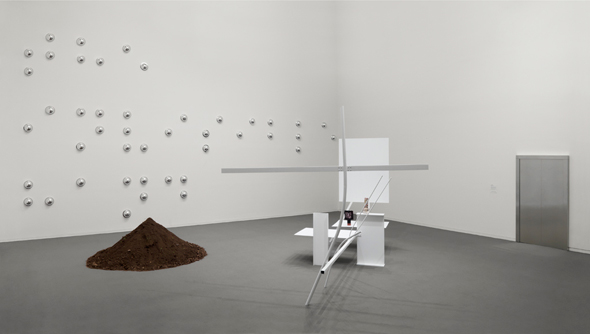
HOW SOON IS NOW - Antonia Hirsch, Holly Ward, Damian Moppett and Christian Kliegel (Photo: Rachel Topham, VAG)
How did you narrow down to the selection of artists in the exhibition?
Well, I didn’t want the show to be generational, for instance, or to have one particular medium dominate. Most of all, I wanted it to reflect the diversity of practices that I was seeing during those studio visits. I also liked the way more traditional works might rub up against unconventional ones. For example, Kyla Mallett made a series using all the detritus and discarded bits of information she found at the Vancouver Art Gallery library, then meticulously photographed them and hung them, framed, on the wall. But behind the wall was a work by Mark Soo, which was invisible, except for this sound of deep, reverberating base. So if you were close enough to the wall, it actually vibrated, but what it sounded like was that somebody on the other side of the wall was throwing a party. I really liked these moments where two artworks would meet each other in a productive collusion.
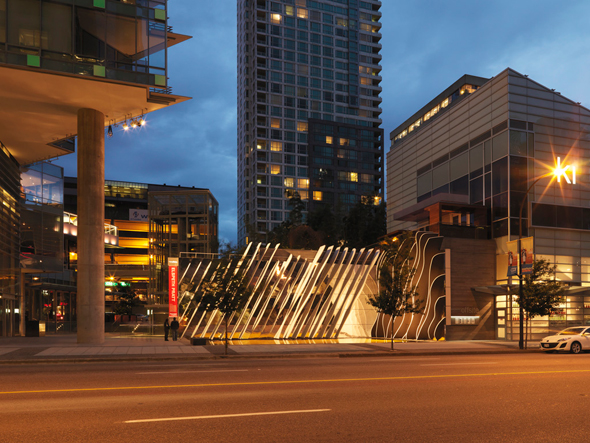
OFFSITE - 'Second Date' by Elspeth Pratt, June 29, 2011 to January 8, 2012 (Photo: Rachel Topham, VAG)
Tell me a bit about the Elspeth Pratt installation at Offsite.
Elspeth is a really interesting artist because she’s had a very long history here in Vancouver. She has made very beautiful and provocative sculptural work over the years; a practice that has been low-key and incredibly consistent. I remember we did an exhibition of her work at Artspeak in 2002, and I was impressed with her use of everyday building materials – things that you could find at Home Depot, like wood, foam and paint – to make this works that seem quite precarious and very vulnerable, going against all of our assumptions of traditional sculpture which are supposed to communicate a sense of timelessness and universality. Her sculptures work entirely against those expectations.
The other thing that’s important about Elspeth’s practice is that her work often directly references architecture. It informs her practice, so she seemed like a natural choice for Offsite. Previously, she has always worked on a very modest scale, so I was very curious to see what she would do on a large scale and in public. We invited her to do a concept proposal, and she did this beautiful sketch where she examined the architecture of the site and imagined extruding or collapsing different parts of it. She turned anything that was a right angle into a curve, or gave it a reflective surface, so much so that the architecture suddenly became quite foreign. She took the framing wall at Offsite, which is this very rigid, modernist grid, and changed it into something uncanny by putting these big, curvy fins at a 45-degree angle and then coating the back surface with a reflective vinyl, and then covering the reflecting pool in bright yellow pool liner. It was with a real economy of means she just transformed the space. It looks almost – and I say this in a nice way – it looks almost goofy.
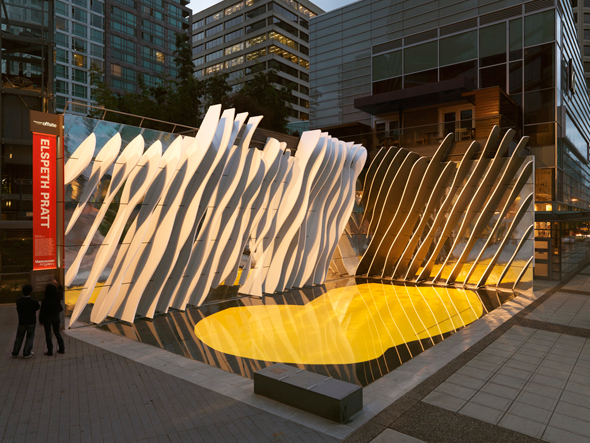
OFFSITE - 'Second Date' by Elspeth Pratt, June 29, 2011 to January 8, 2012 (Photo: Rachel Topham, VAG)
To me it really suits that space, almost better than any other installation that has been there. The conversation it’s creating between Shangri-La and everything around it is really nice.
I think what it does too is make you critically reflect on the architecture that surrounds it. When I see it, it makes me look at everything else in this area of the city and wonder why it is so standardized. Elspeth was very careful that every shape that she made would never be repeated, so it really looks funky. As part of research, she was really interested in ideas of ornamentation as a sort of anathema to modernist practices in architecture, and how ornamentation is gradually being reintroduced into architectural practice, but now with a kind of functionality attached to it. The piece for Offsite actually references the Aqua Tower in Chicago which was built in 2009 by Studio Gang Architects. It’s a big skyscraper with 86 floors and all of the balconies have these curvy forms. This was part of the inspiration for this work.
What about Heather and Ivan Morison’s installation at Offsite?
That was an enormous project as well. Heather and Ivan are based in the UK and we brought them here to do a site visit. They are interested in ideas of shelter and refuge, but also dystopian literature. So when they saw the site they immediately thought of J.G. Ballard’s novel ‘High-rise’, especially with the Shangri-La building in such close proximity to it, which is the tallest building in Vancouver. What we constructed was a large, wooden structure that’s about three-storeys tall. It was meant to look like a high- rise that has been partially built and then stopped, almost like a ruin. The walls looked like they had been twisted by a giant wind at a five- to eight-degree angle, and they were meant to appear suspended at a particular point, so it seemed like it could fall, or take flight at any moment. The surface of the wood was charred, which is a traditional Japanese technique for actually preserving wood against the elements. On the inside the walls were sort of held together by enormous beams that are un-burnt, so it appeared like a newer material, like an interior scaffolding, was holding it together. The concept of the piece was that the structure would be open, like a pavilion, so people would go inside and they would have lunch or hang out, and just have different relationship to the city. There were lights on the top at night, so people could access it 24 hours a day. I was interested in some of their past work because they had created these pavilions that present a curious invitation to the public. It invites you to literally step into it, to become part of it, and in so doing you become a part of the artwork.
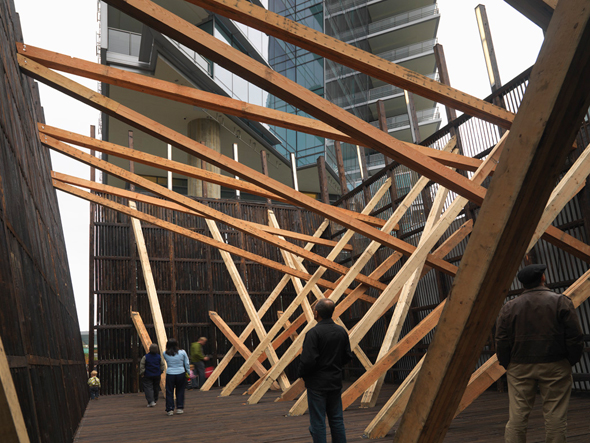
OFFSITE - interior view of 'Plaza' by Heather and Ivan Morison, October 2, 2010 to May 30, 2011 (Photo: Rachel Topham, VAG)
How do you stay up to date on contemporary art?
I read a lot, I go to a lot of exhibitions. I travel a fair bit as well.
What’s your favourite art destination?
I just came back from Venice, from the opening of the Biennale, which was great. I was in New York recently as well. I think that’s part of Vancouver’s interesting history – because we’re geographically isolated, caught in between the mountains and the water, Vancouver artists have often traveled. You think of Jeff Wall and Ian Wallace – they were traveling quite a bit, seeing a lot of art and making connections. What’s interesting about the history of the art scene here is that there is a real commitment to the community and a regional perspective, but it’s always with an eye out to what’s happening globally. Certainly you see that in the new generation of artists as well.
What kind of art spaces, programming, etc would you like to see more of in Vancouver?
I’d always like to see more contemporary art, more spaces dedicated to contemporary art. We have the Contemporary Art Gallery, the Belkin, Centre A, the Charles H. Scott, and a rich history of artist-run centres, and I would simply like to see that grow. I think what’s been interesting about Vancouver in the last several years is how much our public art has grown. With a number of really smart people at the City’s public art program, and groups like Other Sites for Artists Projects, there’s been an explosion of fantastic public art in Vancouver. In a sense art doesn’t have to be contained within the space of a museum or a gallery, it could really happen anywhere.
--------
For more information on the Vancouver Art Gallery, please visit vanartgallery.bc.ca.


